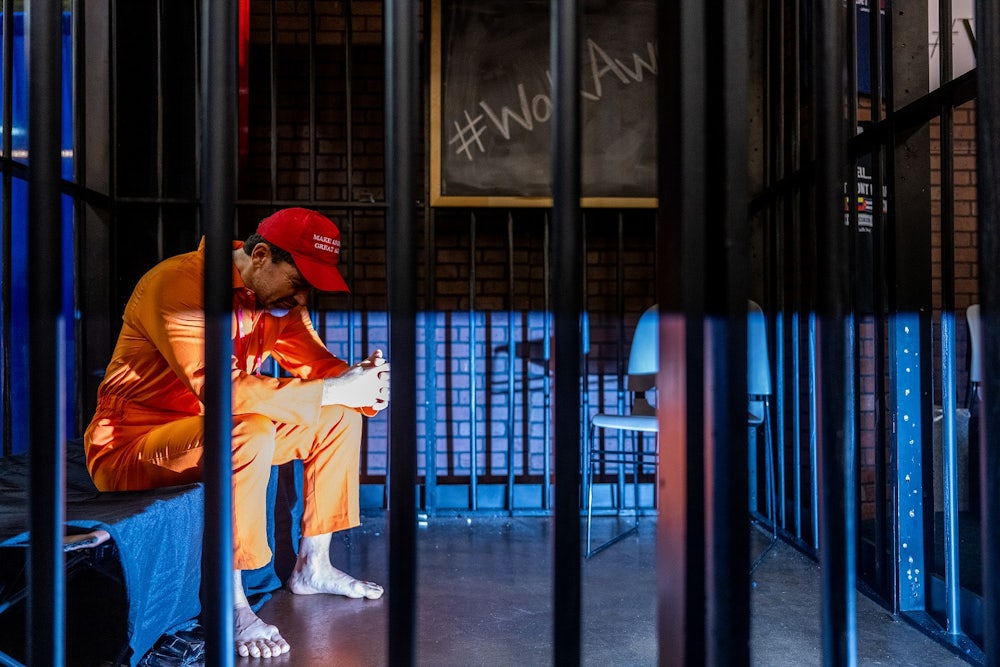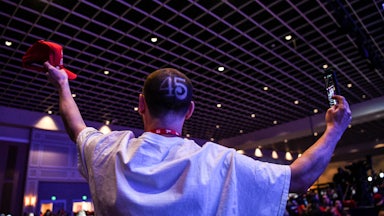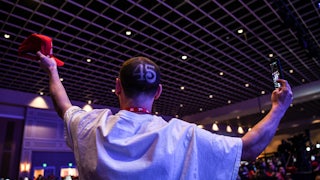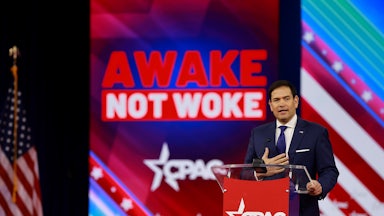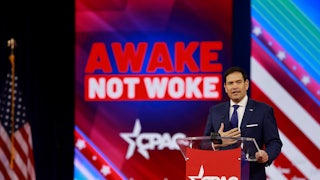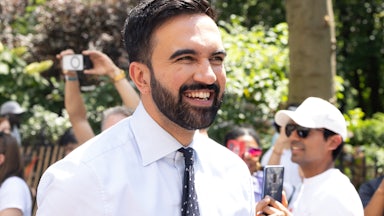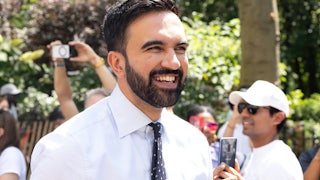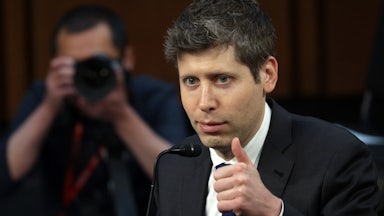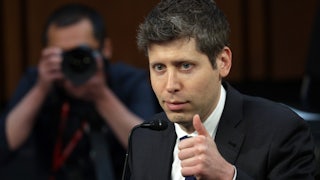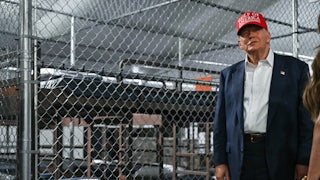Flames engulf the American flag. This inescapable image blazes on the five enormous screens in the Trinity Ballroom in Dallas’ Hilton Anatole. In every direction, fire crackles over the speakers and the music swells. The video smash cuts to a statue of George Washington splattered with red paint as if mauled by some rough beast’s blood-soaked paw—an ursine murder scene frozen just before the inevitable aftermath of our founding father torn down and dashed to pieces on the pavement. An instant later, we see a group of protesters with a rope do just that.
“There’s really a great desecration going on,” a disembodied voice intones as this apocalypse plays out above and around us. “Anything that’s good, anything that’s holy, anything that’s truthful, is being attacked.”
This is CPAC Dallas. We are watching a trailer for “The Culture Killers: The Woke Wars.” By the time this three-day conference ends, we will all have seen this two-minute clip, which plays between nearly every speech, at least a dozen times.
“Cancel culture is real, and it’s coming to a neighborhood near you,” we are told over and over again by Matt Schlapp, who heads the American Conservative Union that hosts the conference. Screaming, rabid protesters flood the screens and our senses. “You’ll lose your job. You’ll be kicked out of the store. You won’t have your place in society.”
This trailer plays between the speeches, but it grows increasingly difficult to separate one from the other.
“The militant left wing in our country has become the enemy within.” Florida Senator Rick Scott announces as his rubber-mask face blandly surveils his audience from both the stage and those enormous screens. “They are working hard to redefine our country, silence their opponents—and that means each of you.”
Later, Lieutenant Governor Dan Patrick begins to quote 2 Chronicles 7:14—“If My people, who are called by My name—,” then turns his attention to the audience. “Let’s break that down. Who are His people? I used to think once upon a time His people were all Americans. That of course Americans want a great America. Well, half this country does not. The left does not believe in the America that we believe in. They’re Marxist socialist communists. It’s obvious.”
“I know they want us to think it is a battle between left and right,” newly-minted Arizona gubernatorial candidate and rising conservative star Kari Lake intones a day later. “But this is truly a battle between those who want to save America and those who want to destroy her. That’s where we are at this moment. My question to you is: Are you in this fight with us?”
The CPAC audience roared their approval of this and every other call to battle, constant and relentless as a hailstorm. By the end of the third day, when Schlapp revealed the conference straw poll results, a whopping 91 percent of attendees were more concerned about “internal threats such as the Deep State, Public Education, and the Mainstream Media” than “External forces such as Russia, China, Iran and North Korea.”
From far enough away, the ritual fury might look like some demented two-minute hate, but this is incorrect. The CPAC experience, which used to be a more staid affair geared toward allowing young conservatives to network in Washington, D.C. among the GOP’s institutional power players, has devolved completely. It has become a four-day fear.
“It felt like I was underwater, like in a dream.”
The woman’s voice is tinged with wonder through the headset I am wearing. It is black with neon piping and designed for silent disco, but no one here is dancing. Instead, we stare through the bars of a cage where Brandon Straka sits, crying. He wears an orange jumpsuit and a red MAGA hat and not once, in the half hour I spend staring incredulous at the spectacle, does he break character.
“After I entered the Capitol, I remember walking down a long hallway with the girl that I was with,” the woman continues. “We walked directly into the dome and I remember stopping and looking up and just thinking in a word: “Beautiful.”
When I switch to the other track, I hear a medley of voices describing what happened later, after the insurrectionists went home—interviews from Capitol Punishment, a documentary by Nick Searcy, the character-actor-turned-auteur whose movie is meant to counter the January 6 Commission.
Sometimes Straka cries on his cot. Sometimes he cries on the floor. Sometimes he takes a break from crying to mark days on the blackboard within this full-sized metal jail cell that sits incongruous amidst the maze of merch tables, informational booths, and pamphleteers that make up CPAC Central. Two small signs hang from the front corners of the cell. They say: #YouNext.
When footage of this curious piece of performance art escaped CPAC and found its way online, social media gleefully lost its mind at what one Twitter user described as the “persecution diorama.” The hackneyed attempt to portray January 6 insurrectionists as the real victims felt ripped directly from the pages of an especially edgy version of The Onion and—worse—seemed to broadcast a complete lack of remorse. To many, it suggested mockery of the very real danger faced by Congress members and Vice President Mike Pence as they fled mere minutes ahead of a mob quite literally howling for blood.
“I’ve put that day out of my mind,” the woman’s voice whispers. “In order for me to get out of the bed every day, in order for me to go to work, in order for me to spend time with family and friends, to function outside of being riddled with anxiety… I had to forget that I frightened my family. I had to forget that I was a part of something that frightened my country.
“I have a sister that doesn’t speak to me.”
On January 25, 2021, the FBI arrested Brandon Straka—the man in the cage—for his role in the January 6 riots. Records show that he received a conditional release the next day. Months later he pled guilty to disorderly conduct and received three years’ probation, $5,500 in fines, and 60 hours of community service. Without the guilty plea (and some level of cooperation with the Justice Department), Straka says he could have faced up to twenty years in prison for a felony riot charge.
“I didn’t know that I could cry for three straight hours,” Straka told me later about his time in the CPAC cage. “I don’t feel like people even see me as a person anymore, as a human being.… All of these people hate a character that isn’t real, and I don’t know what to do about it.”
Straka, who describes himself a former liberal, made a video in 2018 that detailed his journey from left to right. Its viral success inspired him to start the #WalkAway Foundation. By all appearances, his efforts to get others to #WalkAway from the Democratic Party were fueled by bots and heavily astroturfed, but the group and its founder thrived in the Donald Trump ecosystem. Straka found himself invited to many high-profile events, including the January 6 “Stop the Steal” rally in Washington DC.
Straka allegedly tweeted about civil war and revolution to his 500k followers in the days leading up to January 6, and displayed annoyance in the immediate aftermath that everyone shouting about freedom and 1776 suddenly lost their nerve the moment people followed through. Though the influencer did not enter the Capitol himself, he pleaded guilty to encouraging people to both enter the building and wrest a shield away from a police officer.
“I pled guilty. I’ve served the majority of my sentence. I paid my fines,” he said. “When do I get to move forward?” Straka’s conviction, combined with recent speculation about just how much help he gave to federal agents, have made him an incandescent target for the Internet’s wrath. “All of these people hate a character that isn’t real.”
There is some cold solace in all this: The #WalkAway Foundation is extremely solvent. The movement’s PAC has already raised over $250K for the 2022 election cycle. The political gears keep turning no matter how many fingers get stuck in the works.
At CPAC, January 6 never ended. Polls consistently show that 70 percent of Republicans believe Trump won the election, and Trump stokes that fire any chance he gets. Many on the left side of the aisle—myself included—are terrified that Trump will steal the 2024 election if he is not behind bars by then for his 2020 treason. Many are terrified that, without serious consequences for rioters, the next January 6 will be far worse.
But it’s complicated.
Conservatives are frightened too. “It seems to me that there’s this sentiment that any means justify the end, and the end needs to be no more Trump.” Straka says. “With January 6—which, again, was terrible—I do fear that now they’re going to use that as the excuse to be like, we can’t let anything like that ever happen again.” Surveillance. Monitoring. A rising police state.
For Straka, the road to January 6 began with Covid-19. Most Americans thought that lockdowns would be temporary back when all this started—just long enough to “flatten the curve.” Few thought the lockdown would last months. The CDC bungled nearly every step of its response. It offered confusing and often contradictory guidance. Could an American institution actually be this inept? Or was something more nefarious going on?
“I think that to us, everything feels like an attempt to get rid of Trump,” Straka said. Covid lockdowns tanked the economy and necessitated mail-in ballots—something Trump began to turn his base against as early as April 2020. “We all saw very early what was happening, or what we felt like was happening.”
The 2020 election unfolded like a trainwreck. When the red mirage broke to reveal a blue sweep, Trump supporters saw exactly what their leader wanted them to.
“Even if you don’t agree, don’t you understand? The people who were upset thought the election was being stolen. Now you think that the election was being stolen [by Trump] and you’re enraged. You don’t have to agree with us,” Straka says, “but what you’re feeling is what we were feeling.”
Straka hoped the exhibit would help people see that people arrested on January 6 as human beings. It’s safe to say the message reached no one but the choir. The world laughed. The spectators cried. And above all of it, those two implacable signs: #YouNext.
“There is no doubt in anybody’s mind that’s looked at the facts… that the 2020 election was stolen from Donald J Trump.”
Stubble-faced, scabrous, clad in at least three layers of black collared shirt, Stephen K. Bannon takes the podium at the CPAC Cattleman’s Ball, where tickets start at $375 and skyrocket from there. You will not catch this self-styled nationalist reciting bible verses or talking about good versus evil, merely plotting how best to tear open the throat of the American body politic.
“In the next 24 months, starting in November 8 through the 2024 elections, we have the opportunity that will never come again.” He punctuates each word with a descending fist, as though stabbing downwards. “We have the ability to shatter—shatter—the Democratic Party as a national political institution.”
Much like the cockroach, Bannon has proven difficult to squash. And at CPAC, he has become a transformed man—and there is no better marker of how far this conference has drifted in nearly a decade’s time. In 2013, Bannon was a fringe player who created an alternate night of programming during CPAC which he called “The Uninvited.” Four years later, he triumphantly took the main stage as an influential member of Trump’s inner circle, only to fall from grace once more when that relationship soured.
Through sheer obstinacy, Bannon mutated from menacingly uncharismatic puppet master to podcast host, finessed himself into Trump’s begrudging toleration, and wooed American Conservative Union chairman Matt Schlapp on-air until, at last, he took his rightful place as keynote speaker for the event’s 2022 gala dinner. During the day, Bannon broadcast his War Room podcast live from media row. Whenever he was on the air, movement past his studio became nearly impossible as attendees clustered to get a glimpse of the face behind his now-familiar voice.
“All they talk about on MSNBC is democracy, democracy, democracy,” he growls peevishly as he stabs the lectern with two stiff fingers. “We’re gonna give them a democracy suppository on November 8!”
I was unable to talk my way into the gala event, despite numerous attempts, and instead found myself in conversation with a someone I’ll call Mary: a small and unassuming woman who speaks with a directness that cuts to the heart of things. We quietly exchanged opinions on the decisions surrounding admittance and communication amongst the volunteers, then went our separate ways.
Just out of earshot, Bannon laid out the crown jewel of his plan for political domination: the dismantling of what he terms the “administrative state” through the now-infamous Schedule F executive order, which Trump quietly issued in October 2020 and which Biden just as quietly repealed. The order would reclassify any civil servant whose job has any influence over policy as a “Schedule F” employee. This reclassification would eliminate job protections for approximately 50,000 bureaucrats and transform them into at-will employees able to be fired at any time. With Schedule F in place, Trump could fill the civil service with rabid foot soldiers willing and able to smoothly implement any policy the administration might dream up.
“There are no half measures. When we win this time in the house we have to choke down the administrative state with the 4,000 shock troops we’re gonna put in it.” His hand squeezes the air as he imagines it. “And also the appropriations process. We have to cut off the oxygen that feeds the beast.”
The next day, by sheer happenstance, I end up sitting next to Mary as we count down the hours to Donald Trump’s speech. I learn that she volunteers at her church, that she has been a teacher, and that for many years her job involved distilling complicated technical subjects into summaries a busy executive could quickly read and then use. I imagine the job requires deep technical knowledge together with the ability to explain things in a way anyone can understand.
She asks me about my favorite books and tells me hers. Historical fiction, mostly. I write her recommendations down. They look like a lot of fun.
Onstage, a panel moderator claims that most abortions in America occur in the third trimester. I open my mouth to express doubt, but Mary is already whispering to me that two states allow abortions up to 28 days after birth. I tell her I do not think this is true. She admits she has not looked into it. Too upsetting.
Mary does not speak to her own family very much. They find her political views abhorrent. The rifts go deep enough that she was recently unable to attend a close family member’s funeral.
She asks me if I’ve listened to Steve Bannon’s speech yet, and tells me I’m going to love it. He’s brilliant, she tells me. Though you really have to listen to him every day to understand. It’s so nice to have someone with deep technical knowledge able to explain things in a way anyone can understand.
“We’re at war,” Bannon told his audience the night before as he gripped the podium with both hands. “We are at war. We’re at a political and ideological war. You can say anything else you want about it, but we’re at war.”
I ask Mary if she thinks that war is inevitable and she looks surprised at the question. She says the point of these events is to find the courage to say what they believe and stand strong in the face of the various forces marshaled against them. A man behind us overhears and tells us about a movie he recently watched—Doomed to Repeat It—about the parallels between Fidel Castro’s Cuban takeover and the leftist agenda in America.
I have been upfront about who I am and what I do. I tell them I hope it doesn’t come to that.
Later that night, I asked Brandon Straka whether he thinks this is a fight to the death. He hesitates, but eventually answers. “Honestly, if I’m gonna base it off of what I’m personally experiencing, I think we are in big trouble. Like, I don’t feel like people see me as a person anymore. And I don’t think that that is contained just to me.” He tells me about the messages he receives—thousands every day from strangers who hate him. “If they had the opportunity, I feel like they would kill us. I feel like they would lock us all away.”
“When you stop seeing people as people,” he told me, “really bad things happen.”
The first time I saw Donald Trump speak live was at CPAC 2021, not two months after January 6. The Republican party, in shambles, stood shell-shocked at a crossroads. A week earlier, Mike Pence had been a keynote speaker and Trump was not on the program at all. But the party had, at last, made its choice, and Trump drank in the adoration of the crowd like a man dying of thirst. His speech was raw and riveting.
I saw Trump speak again at CPAC Orlando 2022. The speech lacked depth and warmth. Trump put on his show and played the hits; his supporters enjoyed the in-jokes and iconic phrases. Trump’s heart was clearly elsewhere.
This time—the third time—I felt like I was watching an entirely different person: a dilettante who, after 76 years on earth, finally decided to get serious.
“As we gather tonight, our country is being destroyed—more from the inside than out. America is on the edge of an abyss,” he told his eager, terrified audience. “What we do in the next few months and the next few years will determine whether American civilization will collapse or fail, or whether it will triumph and thrive, frankly like never before.”
The time to act is now. “We have to seize this opportunity to deal with the radical left socialist lunatics and fascists. And we have to hit them very, very hard. Has to be a crippling defeat, because our country cannot take it. We don’t have time to wait. Our country is being shot. It’s being destroyed. It’s something we have to do for the future. The future of our country is at stake. We don’t have time to wait years and years. We won’t have a country left.”
Mary, the man behind me, and this entire crowd of thousands are on their feet. “Despite great outside dangers, our biggest threat remains the sick, sinister and evil people from within our own country,” Trump says sadly, and the people scream their terror and approval.
Trump’s speech still wanders, but it now wanders with a purpose. On the subject of antifa, he reflects that he isn’t supposed to send the National Guard into states to put down violence without permission from state governors. But Democrats never seem to want to ask for help. “I think the next time either we’re going for a very quick change or we’re sending them in,” he muses.
Some poetry undergrad really went to town with Trump’s description of American crime. “The streets of our Democrat-run cities are drenched with the blood of innocent victims… and carjackers lay in wait like predators hunting their prey.” The solution: a record-breaking increase in police officers, ICE, and border patrols: all jobs that come with military-grade weaponry and overwhelming statistical support for Donald Trump.
“If you look at countries throughout the world, the only ones that don’t have a drug problem are those that institute the death penalty for drug dealers,” Trump muses, then launches into an extended yarn about a conversation with Xi Jinping on the virtues of “quick trials” and immediate executions.
Trump once again promises to drain the swamp, but he has a plan this time—one that sounds a lot like a legislative Schedule F. “Congress should pass groundbreaking reform empowering the president to ensure that any federal employee who is corrupt, incompetent or unnecessary for the job can be told, ‘You’re fired.’”
And what about the youth? “We have to finally and completely smash the radical left’s corrupt education establishment,” he vows. School prayer and the Bible are in, drag shows and the acknowledgment of trans people are out. “We need to implement strict prohibitions on teaching inappropriate racial, sexual, and political material to America’s schoolchildren in any form whatsoever. And if federal bureaucrats are going to push this radicalism, we should abolish the Department of Education!” On that note, he receives his wildest, longest, loudest standing ovation of the night.
“We are a nation that no longer has a free press,” the former president remarks sadly. “No longer has a fair press. Fake news is all we get and they are the enemy of the people.”
Trump remains committed to the Second Amendment, but only to a point. “[Liberals] take away your guns. They’re not taking away the guns of the bad guy, are they? They’re not going to take away the guns of the bad guy. None of them are giving up their guns. We have to defend our cherished constitution and uphold our heritage as a society built and sustained by Judeo-Christian values.”
That society, it seems, is also owned by Judeo-Christian masters. “No matter how big or powerful the corrupt radicals we are fighting against may be,” Trump says, “no matter how menacing they appear, we must never forget that this nation does not belong to them. This nation belongs to you. This is your home. This is your heritage. This is your country that your American ancestors won with their own courage, defended with their own blood and built with their own hands.”
This is not bluster. It is not a celebrity spectacle. Trump’s speech is a highly-actionable battle plan for the war these conservatives have promoted all weekend.
“If we stop the crime, secure the border, save the economy, defend our culture and take back our democracy,” Trump promises, “then America First conservators will be rewarded with a governing majority that will transform American politics forever. We’re at such an important point. The radical left will be banished into political oblivion. We will save our freedom. We will save our children.”
The crowd roars its approval. Thrills to his every word. And as he ends, as he always does, they recite the ending with him:
We will make America strong again.
We will make America proud again.
We will make America safe again.
And we will Make America Great Again.
As “Hold On I’m Coming” by Sam & Dave plays and Trump basks in the adulation of his loyal foot soldiers, I think about Mary’s missed funeral and the J6 protesters who listened faithfully to all these well-heeled, well-dressed pundits still urging them to give more, sacrifice more, hate more, fear more. For the last five years, I have heard in my left ear a never-ending chorus of “Make Racists Afraid Again,” but I do not think anyone can handle any more fear at this late date, racist or otherwise. Everyone in this ballroom has been rendered so terrified that the fear might paralyze them forever if their terrorizers were not there to direct it towards everything I care about. They are right that the world is broken, right about the untenable misery of the modern world. They are even right that someone is doing it all to them on purpose—weakening them for their own ends, exploiting them in the name of power.
Donald Trump is right. America is on the edge of an abyss. But however bad it was, the overarching message from CPAC is that it will only, and always, get worse for them. There is no bottom to this pit. No utopia awaits them at the end of their purge, only more misery and a fresh round of scapegoats.
“I went there that day to feel like I had some sense of control,” said the voice of the woman from Straka’s performance art piece. “There were so many things that were out of our control. And knocking on doors in 2020 and making phone calls and showing up to rallies… being around my countrymen that had the same values and shared those same beliefs?”
“Those were the moments that made me feel whole again,” she said. “That made me feel like I mattered.”
